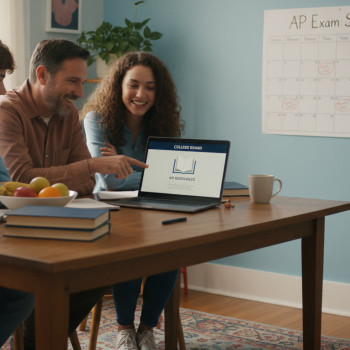Introduction: Why This Choice Matters
Deciding whether to pursue Advanced Placement (AP) courses through an international school or a local school in Thailand or Vietnam is more than an academic preference — it’s a strategic choice that touches college readiness, university applications, language development, and personal confidence. For families and students navigating the transition from secondary school to higher education, understanding the trade-offs, logistics, and support systems available is crucial.

Overview: What AP Is and How It Fits Internationally
Advanced Placement (AP) courses are college-level classes and exams typically administered by the College Board. They allow high school students to deepen their knowledge in subjects like Calculus, Biology, History, and English, and — when scored well — earn college credit or advanced placement at many universities around the world. In Thailand and Vietnam, AP is offered through two primary channels: international schools that include AP in their curricula and local schools that either partner with external providers, offer AP-capable classes, or allow students to self-study and register for AP exams at authorized test centers.
Who Usually Offers AP in Thailand and Vietnam?
- International Schools: Many international or American-curriculum schools include AP courses in their programs and have staff experienced in delivering College Board–aligned instruction.
- Local Schools: Some top-tier local private schools offer AP or AP-style courses, often in bilingual programs; public schools typically focus on national curricula but may support self-motivated students.
- Test Centers and Exam Access: Students may sit AP exams at authorized centers, which can be located in international schools or independent testing centers, depending on the country and year.
Pros and Cons: International Schools vs Local Schools
Choosing between international and local schools for AP is not simply about prestige or cost — it’s about alignment with the student’s goals, language comfort, university targets, and preferred learning style. Below is a comparative snapshot to help you weigh options.
Strengths of International Schools
- Curriculum Alignment: Courses often follow U.S. standards or inquiry-based approaches that map directly to AP expectations.
- Experienced Teachers: Higher likelihood of teachers trained in AP pedagogy and familiar with College Board exam formats.
- Exam Logistics: Easier access to AP exams and established administrative processes for registration and accommodations.
- University Guidance: Robust counseling services geared toward Western university applications and credit transfer processes.
Challenges of International Schools
- Cost: Tuition is generally higher than local schools.
- Culture Fit: Some students may find the environment less rooted in local context or language.
Strengths of Local Schools
- Lower Cost of Attendance: Many local schools are significantly more affordable.
- Strong Local Networks: Closer ties to local universities and communities, which may matter for students planning to study domestically.
- Bilingual Advantage: For bilingual programs, students can strengthen both English and native-language competencies.
Challenges of Local Schools
- Fewer AP-Trained Teachers: Less consistent exposure to teachers with AP experience.
- Exam Access and Logistics: Students might need to travel to an authorized center or coordinate registrations independently.
- Curriculum Mismatch: National curricula may not cover AP depth or pedagogical style, requiring extra study outside class.
Practical Differences You’ll Notice Day-to-Day
Here are some concrete differences students and parents typically observe during a school year.
| Aspect | International School | Local School |
|---|---|---|
| Language of Instruction | Primarily English; supports academic English development | Native language or bilingual; English level may vary |
| Homework & Assessment Style | College-style essays, projects, regular formative assessments | More emphasis on national exam formats; may require independent AP-style practice |
| Access to AP Exams | On-site testing and administrative support | May require registration at external center; less administrative support |
| University Counseling | Targeted assistance for overseas applications | Stronger guidance for local university admissions |
How to Decide: Questions to Ask
Before choosing, families should ask targeted questions to assess fit. Here are the most useful ones.
- What are my university goals — domestic or international? If international, AP is widely accepted and valued by many colleges.
- How strong is the student’s academic English? AP exams are in English and require academic reading and writing.
- Does the school have AP-trained teachers and a history of AP exam administration?
- What support structures exist (tutoring, counseling, study groups)?
- What is the total cost, including exam fees, supplemental tutoring, and travel to test centers if needed?
Study Strategies for AP Success — Regardless of School Type
Whether you’re in an international or local school, the tactics that lead to strong AP outcomes are similar. The following practical strategies are proven and repeatable.
1. Start with the Exam, Then Work Backwards
Identify the AP exam rubric and past free-response questions. Work backwards from the scoring criteria: practice writing for the rubric, time yourself under exam conditions, and review sample high-scoring responses.
2. Build a Realistic Study Calendar
- Map all deadlines and exam dates on one calendar.
- Break content into 6–8 week study chunks, alternating content focus and mixed-practice weeks.
- Include weekly formative assessments and monthly full-length practice exams.
3. Use Active Learning
Passive reading won’t cut it. Use strategies like spaced retrieval (flashcards, closed-book recall), peer teaching, and timed practice essays. For STEM APs, do problem sets and explain solutions aloud.
4. Focus on Past Exam Questions
The College Board’s past free-response questions and scoring guidelines are gold. Practice those under timed conditions and self-score using the official rubrics.
5. Seek Targeted Help Early
Early intervention helps: short, frequent tutoring sessions addressing weaknesses are more effective than last-minute cramming. Personalized tutoring, such as Sparkl’s 1-on-1 guidance, can tailor study plans, close skill gaps, and provide AI-driven insights on progress when time is tight.
Logistics: Registration, Exam Centers, and Accommodations
Practical matters often determine whether a student can realistically take AP exams. Here’s what families should track.
- Exam Registration: Check whether your school registers students. If not, identify an authorized center and understand their deadlines.
- Test Dates and Conflicts: AP exams are scheduled in May; confirm dates early to avoid clashes with national exams and holidays.
- Accommodations: For students with documented needs, apply early for accommodations. International schools often have established processes; local schools may require additional documentation.
- Fees and Payments: Budget for per-exam fees, possible center fees, and any travel costs to reach a testing site.
Real-World Examples and Pathways
Below are realistic student profiles that illustrate how different choices play out.
Example A — International School Student (Bangkok)
Background: Studying at an American-curriculum international school, fluent English, aiming for U.S. universities.
Approach: Enrolled in AP Calculus AB and AP Chemistry through the school, took practice exams provided by the school, and received weekly one-on-one tutoring for weak topics. Counselor helped submit AP scores as part of university applications.
Outcome: Strong AP scores helped satisfy introductory college credit and strengthened application essays that referenced rigorous coursework.
Example B — Local School Student (Ho Chi Minh City)
Background: Attends a top bilingual local school, aiming for a mixture of domestic and international options.
Approach: Self-studied AP Physics 1 with targeted online resources, joined weekend group classes, and registered for the AP exam at a nearby authorized center. Supplemented with periodic private tutoring focusing on problem-solving and English technical vocabulary.
Outcome: Scored well enough to show readiness for STEM programs; used AP performance as leverage in scholarship conversations.
Cost Considerations and Value
Costs vary, and families should balance short-term expense with long-term value.
- Tuition Differences: International schools typically cost more but include in-house AP support; local schools are cheaper but may require extra spending on tutoring and travel.
- Exam Fees: Each AP exam has an associated fee; additional center or administration fees may apply.
- Value: AP coursework and scores can translate into university credit, reduce college course loads, and strengthen admissions profiles — often offsetting upfront costs.
How Sparkl’s Personalized Tutoring Can Fit Naturally Into Both Paths
Regardless of school choice, targeted tutoring is often the X-factor. Sparkl’s personalized approach — 1-on-1 guidance, tailored study plans, expert tutors, and AI-driven insights — complements both international and local pathways. For an international-school student, Sparkl can refine exam techniques and essay responses; for a local-school student, the service can bridge curriculum gaps, strengthen academic English, and provide structured practice regimens.
Checklist: Steps to Take This Year
To keep things practical, here’s a checklist you can act on now.
- Decide which AP subjects align with university goals and current strengths.
- Confirm exam logistics with your school or an authorized center (deadlines, fees, dates).
- Assess English readiness; plan for language support where needed.
- Create a study calendar with content and mixed-practice weeks.
- Schedule periodic full-length practice exams and review sessions.
- Consider a personalized tutor for targeted help; a short consultation with services like Sparkl can help you design a tailored plan.
Common Myths and Honest Answers
Let’s clear up a few misconceptions families often have.
Myth: AP Is Only for Students Applying to U.S. Colleges
Reality: AP is recognized by universities worldwide. Strong AP scores demonstrate academic rigor and readiness for college-level work, which is valuable for many international admissions processes.
Myth: You Must Attend an International School to Succeed in AP
Reality: Determination, the right resources, and effective study strategies can lead to AP success from both local and international schools. What matters is how you prepare and whether you get targeted feedback on practice exams.
Myth: AP Guarantees College Credit Everywhere
Reality: Credit policies vary by university and country. Always check specific university policies — AP can help with placement or credit at many institutions, but it’s not universal.
Final Thoughts: Matching the Path to the Person
There’s no single “best” route for students in Thailand or Vietnam. International schools often provide convenience and alignment with AP expectations, while local schools can offer cost advantages and strong local ties. The deciding factor should be the student’s goals, learning style, and the supports available to them. For students who need that extra scaffolding — whether it’s academic English, exam technique, or tailored pacing — personalized tutoring is a pragmatic complement. Programs like Sparkl provide individualized plans, expert tutors, and AI-driven progress tracking that fit naturally into either school pathway, helping students convert effort into measurable results.

Resources for Next Steps (Practical)
Start with these practical next steps:
- Talk to your school counselor about AP course availability and exam registration.
- Join a small study group to exchange practice questions and timed essays.
- Schedule a short diagnostic or consultation with a tutor to identify gaps and build a 6–8 week action plan — targeted support early pays off.
- Map your AP subjects against your university list so you prioritize the most impactful exams.
Closing Encouragement
Choosing between international and local AP options in Thailand and Vietnam can feel like a big decision, but it’s fundamentally a question of fit. Match your school environment to your goals, prioritize consistent, active practice, and get help when you need it. With thoughtful planning and focused effort — whether through school resources, study groups, or personalized tutors like Sparkl — students can make AP a powerful stepping stone to their next chapter. Take it one step at a time, measure progress, and let results guide your next moves.
Short Action Plan
- Week 1: Choose AP subjects, confirm exam logistics, and create a study calendar.
- Weeks 2–6: Complete content blocks, begin timed practice, and book a tutor if needed.
- Weeks 7–12: Take full-length practice exams, refine weak areas, and finalize exam registration.
- Final Month: Focus on timed practice, exam strategies, and rest before test day.
Good luck — and remember, AP is a marathon, not a sprint. Bite-sized progress and smart support are what turn preparation into achievement.




















No Comments
Leave a comment Cancel